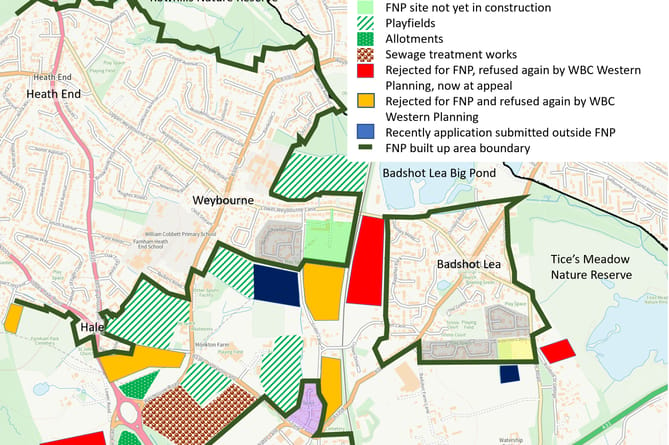The current planning system is completely broken, writes Catherine Powell, the Farnham Residents county councillor for Farnham North.
Neighbourhood Plans were supposed to manage where new developments were permitted to meet housing allocations within local constraints. However, the protection they offer against speculative development reduces after only two years.
There is a lot of money to be made from developments on low-value green fields with a desirable Surrey postcode, such as in Farnham.
So developer after developer continue to apply for sites that have been reviewed and rejected multiple times by the planning process, in the hope that eventually they will get their development through.
The costs of dealing with repeat applications by the council are very significant, deflecting taxpayer money from essential public services.
Each planning application is assessed on a standalone basis and the cumulative impact is essentially ignored. No consideration is given to schools, doctors, utilities, etc, nor does current flood-risk guidance really cover climate change impacts.
The Farnham map above shows virtually every field of the surface water floodplain, repeatedly receiving speculative applications. As soon as one was granted on appeal, the developers have felt emboldened.
The review of every major development application involves hundreds of hours of work by:
Waverley Borough Council, Farnham Town Council and Surrey County Council officers and councillors;
Statutory consultee officers;
Local residents and groups.
That’s even before the first decision where the Waverley officers recommend to refuse or permit. Thereafter, most major applications go to Waverley’s western planning committee.
Waverley officers produce a report and committee members invest their time to review and listen to representations at the planning meeting.
If the application is refused then you can virtually guarantee the developer will take it to appeal, as there is no real penalty not to do so.
Going to appeal means all of the same people looking at it again, along with any amended information as part of the appeal process, but this time it also goes to the Planning Inspectorate who also invest more time and effort. The Inspectorate will ultimately make a decision, but if refused, the developer simply recommences the cycle again, without recourse.
Thousands of public-service hours are wasted each cycle; the nominal planning application cost doesn’t even scratch the surface of the cost to the councils. Developers are manipulating a broken system for their own gain at the cost of other council services.
The cost to the developer of an appeal is extremely low compared to the cost of the hours to Waverley and other statutory consultees.
And the hours from volunteers fighting these speculative developments could also be better applied in the community instead of fighting commercial interests.
One example of this failed system is the land at Lower Weybourne Lane between the railway line and Badshot Lea, on to its third appeal:
2014 – application made for 140 houses, refused by Waverley and appeal dismissed in 2018.
2019 – application made for 140 houses, refused by Waverley and appeal dismissed in 2021.
2022 – application made for 140 houses, refused by Waverley and within four months an appeal had started. Representations had to be with the Inspectorate by January 17, 2023.
The only place the broken planning system can be fixed is at the central government level. There is a consultation on the National Planning Policy Framework (NPPF) going through now, with the consultation period closing on March 2, 2023.
The real challenge for Farnham people is that any update to the NPPF isn’t likely until the summer and by then it could be too late for some of the floodplains and fields in Farnham.
People in Farnham really need to engage with the planning system, and help fight for protection of our surface water floodplains and green spaces. Lobbying your local MP and the secretary of state will also help.



